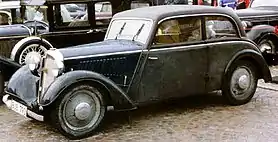| DKW F5 Reichsklasse / Meisterklasse | |
|---|---|
 | |
| Overview | |
| Manufacturer | Auto Union AG |
| Production | 1935–1936 |
| Assembly | Zwickau |
| Body and chassis | |
| Layout | FF layout |
| Powertrain | |
| Engine | 584 cc & 692 cc two-stroke straight-2 |
| Transmission | 3-speed manual |
| Dimensions | |
| Wheelbase | 2,610 mm (103 in) (Reichsklasse sedan) |
| Length | 3,750 mm (148 in) (Reichsklasse sedan) |
| Width | 1,430 mm (56 in) (Reichsklasse sedan) |
| Height | 1,480 mm (58 in) (Reichsklasse sedan) |
| Curb weight | 700 kg (1,500 lb) (Reichsklasse sedan) |
| Chronology | |
| Predecessor | DKW F2 DKW F4 |
| Successor | DKW F7 |
.jpg.webp)
The DKW F5 is a sub compact front wheel drive saloon launched by Auto Union's DKW division in 1935 as a replacement for the DKWs F4 (Meisterklasse) and F2 (Reichsklasse) models.
The body
The appearance of the F5 was little changed from those of the F2 and F4. However, the timber-frame construction of the central portion of the body was, in the F5, replaced with a steel frame. The outer skin of the body remained of fabric construction, with plywood support.
There were two broadly similar F5 saloons, sold as the Reichsklasse and Meisterklasse. They shared the same track and wheelbase, but the Meisterklasse was 3.5 cm longer. There were also two-seater cabriolet versions of each, along with a lighter bodied ‘Front Luxus Sport’ sports cabriolet for which a higher top speed of 90 km/h (56 mph) was claimed.
Engine and running gear
The cars had the two-cylinder two-stroke engines of their predecessors. The Reichsklasse engine was of 584 cc with an output of 18 bhp (13 kW). The Meisterklasse's 692 cc engine had an output of 20 bhp (15 kW). Respective claimed top speeds were 80 and 85 km/h (50 and 53 mph).
DKW had been producing small front wheel drive sedans since 1931. The incorporation of front wheel drive in the F5 was at this time still strikingly innovative in terms of the wider auto market, however.
The car featured a three-speed manual transmission system.
Commercial
Production of the F5 saloon ended in 1936 while production of the 20 bhp (15 kW) cabriolet versions continued for a further year. The car was replaced by the DKW F7. By the time that happened, approximately 60,000 F5s had been produced, placing this car among Germany's top sellers.
Data
| DKW F5 | ’Reichsklasse’ | ’Meisterklasse’ | ’Front’ Cabriolet | ’Front Luxus’ Cabriolet | ’Front Luxus Sport’ | |
|---|---|---|---|---|---|---|
| Body | 2-door saloon | 2-door saloon | 2-seater cabriolet | 2-seater cabriolet | 2-seater roadster | |
| Produced: | 1935–1936 | 1935–1936 | 1936 | 1936–1937 | 1936–1937 | |
| Engine: | Two-stroke 2-cylinder water-cooled, front-mounted | |||||
| Displacement: | 584 cc | 692 cc | 584 cc | 692 cc | 692 cc | |
| Bore x stroke: | 74 x 68 | 76 x 76 | 74 x 68 | 76 x 76 | 76 x 76 | |
| Max. power : | 18 hp (13 kW) | 20 hp (15 kW) | 18 hp (13 kW) | 20 hp (15 kW) | 20 hp (15 kW) | |
| Electrical system: | 6 volt | |||||
| Max. speed : | 80 km/h (50 mph) | 85 km/h (53 mph) | 80 km/h (50 mph) | 85 km/h (53 mph) | 90 km/h (56 mph) | |
| Dry weight: | 700 kg (1,500 lb) | 770 kg (1,700 lb) | 650 kg (1,430 lb) | 790–820 kg (1,740–1,810 lb) | 700 kg (1,500 lb) | |
| Track front/ rear: | 1,110 mm (44 in) 1,220 mm (48 in) | 1,110 mm (44 in) 1,220 mm (48 in) | 1,110 mm (44 in) 1,220 mm (48 in) | 1,110 mm (44 in) 1,220 mm (48 in) | 1,110 mm (44 in) 1,220 mm (48 in) | |
| Wheelbase: | 2,610 mm (103 in) | 2,610 mm (103 in) | 2,400 mm (94 in) | 2,610 mm (103 in) | 2,500 mm (98 in) | |
| Length: | 3,750 mm (148 in) | 3,985 mm (156.9 in) | 3,450 mm (136 in) | 3,995 mm (157.3 in) | 3,745 mm (147.4 in) | |
| Width: | 1,430 mm (56 in) | 1,465 mm (57.7 in) | 1,450 mm (57 in) | 1,480 mm (58 in) | 1,440 mm (57 in) | |
| Height: | 1,480 mm (58 in) | 1,500 mm (59 in) | 1,440 mm (57 in) | 1,440 mm (57 in) | 1,410 mm (56 in) | |